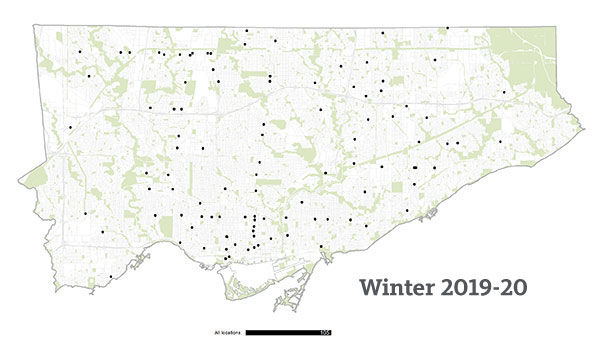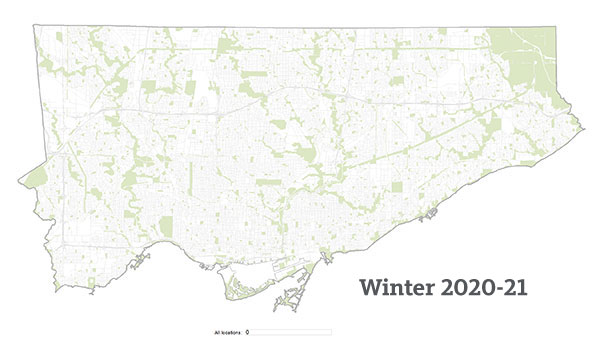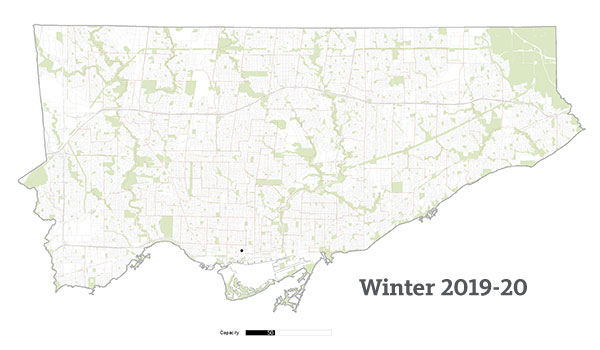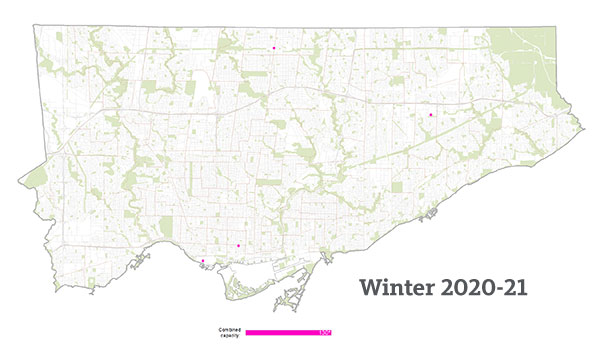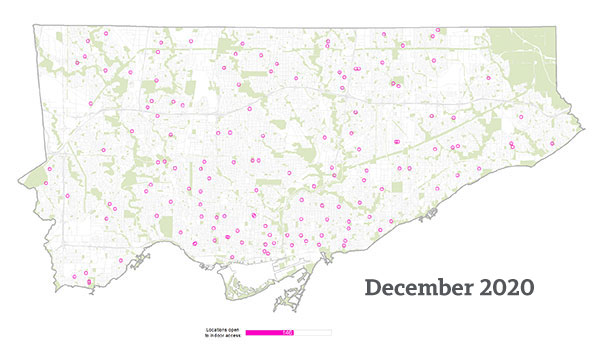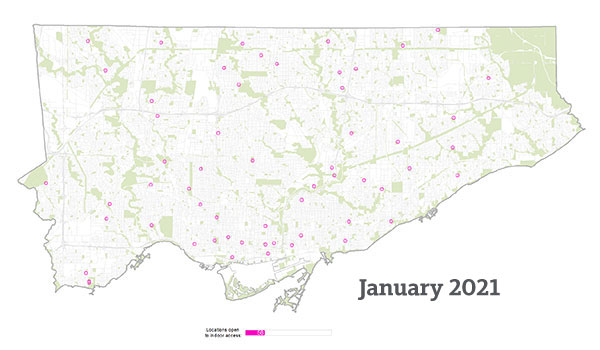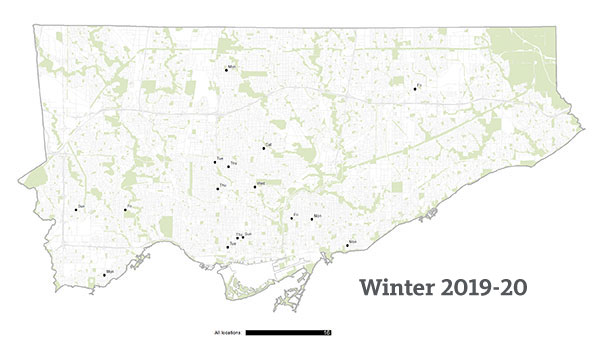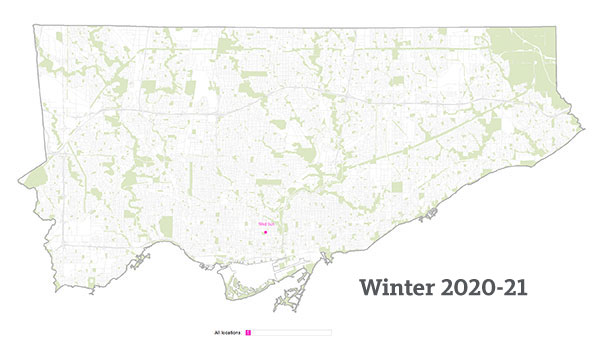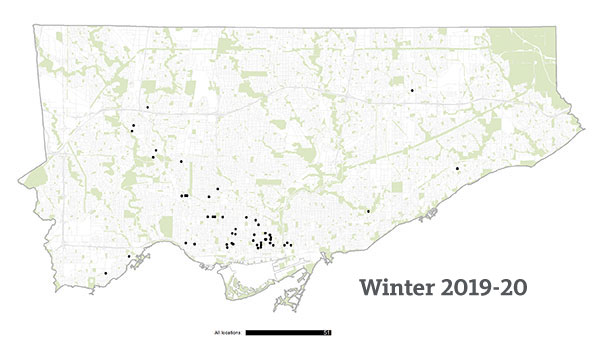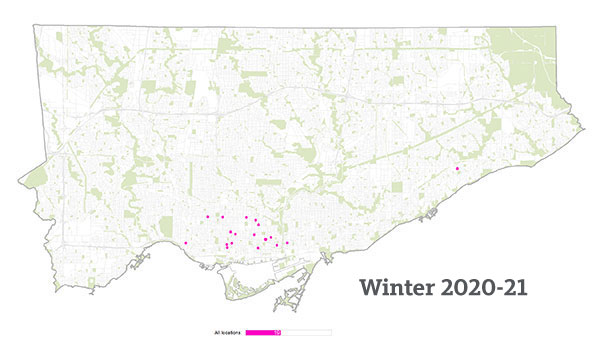Please note, this data is from 2020/21, is outdated, and will not be updated.




This project examines the loss of indoor public space in Toronto during the COVID-19 pandemic.
What we found: There is a severe lack of access to indoor public space, even during cold weather alerts. The City of Toronto’s “Winter Plan for People Experiencing Homelessness” does not address this lack of access.
Although the situation has been exacerbated by the pandemic, the lack of safe, accessible, indoor space in Toronto, in particular during the winter, is a longstanding issue.
What we concluded: There are many opportunities to open up additional space. For example, there are a range of buildings—including City-run buildings—that are currently closed to use. However, ventilation and filtration practices are critical to reducing airborne transmission of COVID-19 indoor spaces. The good news: there are many ways to improve ventilation and filtration practices in the short and long term.
Please keep in mind:
- We did not look at how welcoming specific public spaces are or were to people looking to come in out of the cold. There will be significant variation between sites.
- These maps are a point-in-time snapshot of the loss of indoor public space in Toronto in the winter of 2020/21. They are not meant as an ongoing resource, and will not be updated.
- Hours and services for the locations noted on the maps will continue to change, and some services are only for the winter. Please seek out updated information before visiting locations, or referring people to locations.
24-Hour chain coffee shops and restaurants
In 2019, there were more than 100 restaurants and coffee shops that both were open all night and close to 24-hour transit.
In January 2021, due to pandemic restrictions, all of these locations were closed to indoor dining. Some 24-hour locations are still open for take-out or drive-through. Bathroom access at these locations is variable.
For more information including statistics, background, methods and detailed maps, click here.
Warming centres
In 2019/20, the City had one warming centre with a capacity of 50. In 2020/21, there are four warming centres, with the capacity to accommodate between 130 and 145 people citywide. Warming centres are opened during extreme cold weather alerts, or in other circumstances at the City’s discretion.
The increase in capacity of approximately 95 spaces over 2019/20 is a positive development. It does not compensate, however, for the loss of public indoor space city-wide captured by the other maps included in this project. Access to public indoor space will remain important, even after the cold weather subsides.
For more information including statistics, background, methods and detailed maps, click here.
Libraries and city-run community spaces
In January 2021, libraries offered no indoor access, while the community centres that remained open largely only offered bathroom access, with a few exceptions.
As the province moves in and out of different types of pandemic restrictions, it is very difficult to track what is available, where and when.
For more information including statistics, background, methods and detailed maps, click here.
Out of the Cold program
The 16 Out of the Cold programs (OOTC) running in 2019/20 offered dinner and drop-in programming to people who stayed to sleep.
They also offered dinner and drop-in programming to approximately 130 additional people each week who did not stay to sleep.
While the beds associated with the OOTC program have been replaced, the drop-in and dinner programming has not.
For more information including statistics, background, methods and detailed maps, click here.
Toronto Drop-in Network members with indoor access
The Toronto Drop-In Network (TDIN) includes over 50 members.
In February 2021, the number of drop-ins offering access to indoor space has dropped by approximately 60 per cent, from 51 to 19. Of the TDIN drop-ins still offering services indoors, many have reduced hours and capacity, and some now require appointments.
Several drop-ins that are not offering services indoors continue to serve take-out meals and support people in various outreach capacities.
For more information including statistics, background, methods and detailed maps, click here.
Learn more
- Recommendations for seeking funds to support air quality improvements in public spaces: Updated March 2021
- Read the interim report: December 2020

